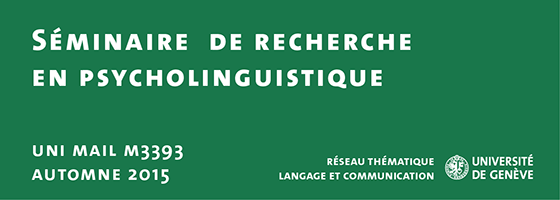Séminaire de psycholinguistique

Responsables: Prof. Ulrich Frauenfelder, Dr Julie Franck
Les séminaires ont lieu les lundis de 12h15 à 13h45 dans la salle M3393 à Uni Mail
Programme des invités externes
16 novembre 2015
Roberto Bottini (Center for Mind/Brain Sciences, U. Trento), The nature of sensorimotor facilitation by subliminal words. Embodied or disembodied?
Theories of Embodied Semantics (ES) suggest that a critical part of understanding what a word means consists in the re-instantiation of the sensorimotor experience related to the word’s referent. Some proponents of ES have suggested that sensorimotor activations are mandatory and highly automatic during semantic processing. Evidence supporting this claim comes from masked priming studies showing that unconsciously perceived spatial words (e.g. up, down) can directly modulate action performance on the basis of their long-term meaning. However, a critical analysis of these results reveals that such priming effects can be explained also in terms of symbolic (disembodied) semantic priming or non-semantic stimulus-response mapping.
In this study we sought to understand whether conscious access is necessary for sensorimotor processing to take place during language understanding. We used spatial words as a test-bed and across six experiments we progressively exclude the possibility that action priming could be explained by stimulus-response mapping or symbolic
semantic priming. Across experiments a priming effect emerged only when also disembodied mechanisms could take place. When the possibility of symbolic priming is prevented, allowing only for a genuinely embodied effect, no priming effect was found. Conversely, in the same experimental paradigm, when embodied priming is prevented and symbolic priming is allowed a facilitation effect emerged again. We conclude that there is no convincing evidence that unconsciously perceived words can activate sensorimotor processes, although these words are processed up to the semantic level. Sensorimotor activations might need conscious access to emerge during language understanding.
23 novembre 2015
Beth Jeffries (U. of York, UK), The components of semantic cognition: Evidence from neuropsychology, neuroimaging and brain stimulation.
Our neuropsychological research has contrasted degradation of amodal knowledge following atrophy of the anterior temporal lobes (ATL) in semantic dementia (SD), with poor control of semantic retrieval following frontoparietal stroke in semantic aphasia (SA). This dissociation between knowledge representation (in ATL) and controlled retrieval processes (in LIFG) is well-established in the literature but controversy remains about the contribution of posterior temporal and inferior parietal regions to semantic cognition. These regions could contribute to networks supporting automatic and controlled retrieval respectively; however, an alternative interpretation of this dissociation (the “two hubs” hypothesis) is that ATL captures knowledge of object identity, while temporoparietal cortex captures thematic associations (impaired in patients with SA). I will present some recent neuropsychological, TMS, fMRI and MEG evidence consistent with the first of these two views.
14 décembre 2015
Silvia Albertini (IUSS of Pavia, Italy), The sentence randomization task : a method for assessing the psychological reality of phrase structure
Taking advantage of the random generation tasks capability to elicit chunking in order to alleviate executive demands, we designed a novel experimental task, called Sentence Randomization Task (SRT), where participants were asked to memorize short simple sentences and to recall them modifying the word order in a random way. If the recall was based on a hierarchical representation of the phrase structure rather than on the sequential information accessible to the rehearsal mechanism, we expected that the word pairs belonging to the same phrase would show a higher tendency to be recalled as chunks compared to word pairs belonging to different phrases, and this effect would not be simply predicted by the co-occurrence probability of word pairs. Experimental results revealed that participants generated poorly randomized sequences that reflected an implicit immediate constituent analysis of the stimuli, suggesting that syntactic representations are shared between language processing and verbal working memory. The SRT thus turned out to be a promising method for assessing the psychological reality of phrase structure in a novel manner.
Télécharger le programme au format PDF
10 nov. 2015